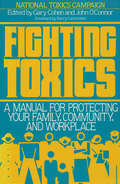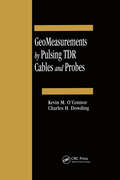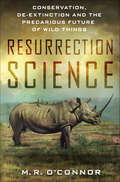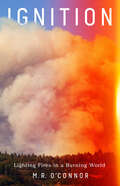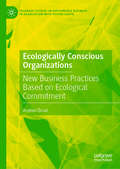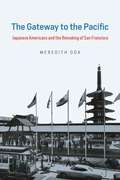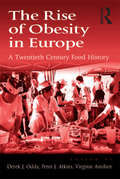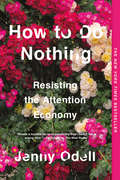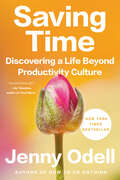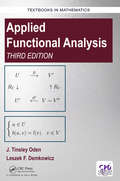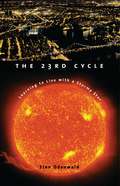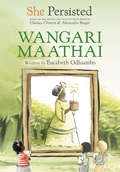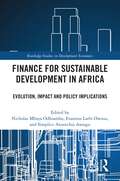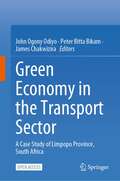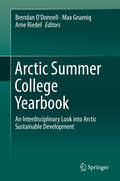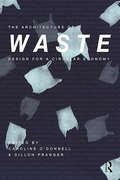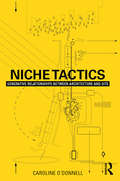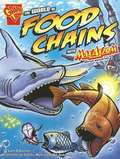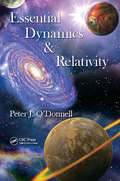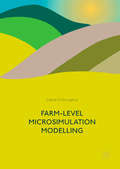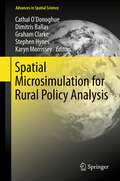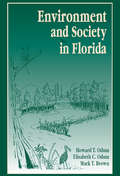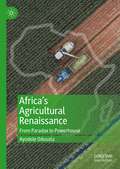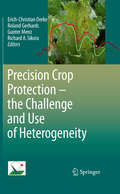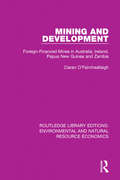- Table View
- List View
Fighting Toxics: A Manual for Protecting your Family, Community, and Workplace
by John O'Connor Barry Commoner Gary Cohen Barry National Toxics CampaignFighting Toxics is a step-by-step guide illustrating how to investigate the toxic hazards that may exist in your community, how to determine the risks they pose to your health, and how to launch an effective campaign to eliminate them.
GeoMeasurements by Pulsing TDR Cables and Probes
by Kevin M O'Connor Charles H DowdingGeoMeasurements by Pulsing TDR Cables and Probes examines Time Domain Reflectometry (TDR) research and provides information on its use as a robust, reliable, and economical production tool.Common uses for TDR technology include telecommunications and power industries, but the text examines applications such as measurement of moisture of unsaturated soils; detection of fluids for leak and pollution; measurement of water levels for hydrological purposes; measurement of water pressures beneath dams; and deformation and stability monitoring of mines, slopes, and structures.Chapters discuss:basic physics of signal generation, transmission, and attenuation along the coaxial cableprobe designs and procedures for calibration as well as the variation in probe responses to changes in water content and soil mineralogyvariations in waveform characteristics associated with cable, deformation, cable calibration, and installation techniques for metallic cables in rockseveral cases demonstrating the use of TDR cables in soil as well as weathered and soft rocka rationale for the use of compliant cable in soilthe use of metallic cable (MTDR) and optical fiber (OTDR) to monitor response of structuressensor/transducer components, connections from the sensors to the TDR pulser/sampler, and system control methodsavailable software for transmission and analysis of TDR signatures The diverse interest and terminology within the TDR community tends to obscure commonalities and the universal physical principles underlying the technology. The authors seek to crystallize the basic principles among the seemingly divergent specialties using TDR technology in geomaterials. By examining varied experiences, GeoMeasurements by Pulsing TDR Cables and Probes provides a synergistic text necessary to unify the field.
Resurrection Science: Conservation, De-Extinction and the Precarious Future of Wild Things
by M. R. O'Connor**A Library Journal Best Book of 2015 ****A Christian Science Monitor Top Ten Book of September**In a world dominated by people and rapid climate change, species large and small are increasingly vulnerable to extinction. In Resurrection Science, journalist M. R. O'Connor explores the extreme measures scientists are taking to try and save them, from captive breeding and genetic management to de-extinction. Paradoxically, the more we intervene to save species, the less wild they often become. In stories of sixteenth-century galleon excavations, panther-tracking in Florida swamps, ancient African rainforests, Neanderthal tool-making, and cryogenic DNA banks, O'Connor investigates the philosophical questions of an age in which we "play god" with earth's biodiversity. Each chapter in this beautifully written book focuses on a unique species--from the charismatic northern white rhinoceros to the infamous passenger pigeon--and the people entwined in the animals' fates. Incorporating natural history and evolutionary biology with conversations with eminent ethicists, O'Connor's narrative goes to the heart of the human enterprise: What should we preserve of wilderness as we hurtle toward a future in which technology is present in nearly every aspect of our lives? How can we co-exist with species when our existence and their survival appear to be pitted against one another?
Ignition: Lighting Fires in a Burning World
by M.R. O'ConnorA work of on-the-ground reporting into the science of, and cultural ideas around, wildfires and fire management that challenges the ethos of the conservation movement, offering a hopeful vision of the connection between humans and our environment. In a riveting investigation of the science and ecology of wildfires, journalist M.R. O'Connor ventures into some of the oldest, most beautiful, and remote forests in North America to explore the powerful and ancient relationship between trees, fires, and humans. Along the way, she describes revelatory research in the fields of paleobotany and climate science to show how the world's forests have been shaped by fire for hundreds of millions of years. She also reports on the compelling archeological evidence emerging from the field of ethnoecology that proves how, until very recently, humans were instigators of forest fires, actively molding and influencing the ecosystems around them by inserting themselves into the loop of a natural biological process to start &“good fires.&” As she weaves together first-hand reportage with research and cultural insights, O'Connor also embeds on firelines alongside firefighters and &“pyrotechnicians.&” These highly trained individuals are resurrecting the practice of prescribed burning in an effort to sustain fire-dependent forest ecologies and prevent the catastrophic wildfires that are increasing in frequency and intensity as a result of global warming. Hailing from diverse backgrounds including state and federal agencies, scientific laboratories, and private lands and tribal nations, these fire starters are undertaking a radical and often controversial effort to promote, protect, and expand the responsible use of fire to restore ecological health to landscapes. At the heart of Ignition is a discussion about risk and how our relationship to it as a society will determine our potential to survive the onslaught of climate change.
Ecologically Conscious Organizations: New Business Practices Based on Ecological Commitment (Palgrave Studies in Sustainable Business In Association with Future Earth)
by András ÓcsaiThis book investigates the value orientation of ecologically conscious business. It analyzes, in a systematic and comparative way, the value commitments and business models of exemplary ecologically conscious businesses from around the world.Ecological consciousness is gaining importance in modern business thinking, as the effects of the Anthropocene – acidification of oceans, diminishing potable water, climate change, and decreasing biodiversity – are becoming more evident. Surviving this ecological crisis requires a radical inner transformation of humanity, and an ecological transformation of business and the economy.This book is valuable reading for masters and Ph.D. students, as well as academics, business practitioners, and policymakers who are working in the field of business ethics, business and the natural environment, business and society, sustainability, and corporate social responsibility. It also serves as general reading for reflective practitioners who are interested in progressive, ecologically conscious businesses, ethical business functioning, and business model innovation.
The Gateway to the Pacific: Japanese Americans and the Remaking of San Francisco (Historical Studies of Urban America)
by Meredith OdaIn the decades following World War II, municipal leaders and ordinary citizens embraced San Francisco’s identity as the “Gateway to the Pacific,” using it to reimagine and rebuild the city. The city became a cosmopolitan center on account of its newfound celebration of its Japanese and other Asian American residents, its economy linked with Asia, and its favorable location for transpacific partnerships. The most conspicuous testament to San Francisco’s postwar transpacific connections is the Japanese Cultural and Trade Center in the city’s redeveloped Japanese-American enclave. Focusing on the development of the Center, Meredith Oda shows how this multilayered story was embedded within a larger story of the changing institutions and ideas that were shaping the city. During these formative decades, Oda argues, San Francisco’s relations with and ideas about Japan were being forged within the intimate, local sites of civic and community life. This shift took many forms, including changes in city leadership, new municipal institutions, and especially transformations in the built environment. Newly friendly relations between Japan and the United States also meant that Japanese Americans found fresh, if highly constrained, job and community prospects just as the city’s African Americans struggled against rising barriers. San Francisco’s story is an inherently local one, but it also a broader story of a city collectively, if not cooperatively, reimagining its place in a global economy.
The Rise of Obesity in Europe: A Twentieth Century Food History
by Derek J. OddyTwentieth century Europe went through a dramatic transition from low income populations experiencing hunger and nutritionally inadequate diets, to the recent era of over-consumption and growing numbers of overweight and obese people. By examining the trends in food history from case studies across Europe, this book offers a historical context to explain how and why this transition has occurred and what we can learn in order to try and address the vitally important issues arising from obesity in contemporary Europe.
How to Do Nothing: Resisting the Attention Economy
by Jenny OdellA galvanizing critique of the forces vying for our attention—and our personal information—that redefines what we think of as productivity, reconnects us with the environment, and reveals all that we’ve been too distracted to see about ourselves and our world <P><P>Nothing is harder to do these days than nothing. But in a world where our value is determined by our 24/7 data productivity . . . doing nothing may be our most important form of resistance. So argues artist and critic Jenny Odell in this field guide to doing nothing (at least as capitalism defines it). <P><P>Odell sees our attention as the most precious—and overdrawn—resource we have. Once we can start paying a new kind of attention, she writes, we can undertake bolder forms of political action, reimagine humankind’s role in the environment, and arrive at more meaningful understandings of happiness and progress. <P><P>Far from the simple anti-technology screed, or the back-to-nature meditation we read so often, How to do Nothing is an action plan for thinking outside of capitalist narratives of efficiency and techno-determinism. Provocative, timely, and utterly persuasive, this book is a four-course meal in the age of Soylent. <P><P><b>A New York Times Bestseller</b>
Saving Time: Discovering a Life Beyond the Clock
by Jenny OdellWe are living on the wrong clock, and it is destroying us. The New York Times bestselling author of How to Do Nothing offers us different ways to experience time in this dazzling, subversive, and deeply hopeful book. <p><p>In her first book, How to Do Nothing, Jenny Odell wrote about the importance of disconnecting from the “attention economy” to spend time in quiet contemplation. But what if you don’t have time to spend? <p><p>In order to answer this seemingly simple question, Odell took a deep dive into the fundamental structure of our society and found that the clock we live by was built for profit, not people. This is why our lives, even in leisure, have come to seem like a series of moments to be bought, sold, and processed ever more efficiently. Odell shows us how our painful relationship to time is inextricably connected not only to persisting social inequities but to the climate crisis, existential dread, and a lethal fatalism. <p><p>This dazzling, subversive, and deeply hopeful book offers us different ways to experience time—inspired by pre-industrial cultures, ecological cues, and geological timescales—that can bring within reach a more humane, responsive way of living. As planet-bound animals, we live inside shortening and lengthening days alongside gardens growing, birds migrating, and cliffs eroding; the stretchy quality of waiting and desire; the way the present may suddenly feel marbled with childhood memory; the slow but sure procession of a pregnancy; the time it takes to heal from injuries. Odell urges us to become stewards of these different rhythms of life in which time is not reducible to standardized units and instead forms the very medium of possibility. <p><p>Saving Time tugs at the seams of reality as we know it—the way we experience time itself—and rearranges it, imagining a world not centered on work, the office clock, or the profit motive. If we can “save” time by imagining a life, identity, and source of meaning outside these things, time might also save us. <p> <b>New York Times Bestseller</b>
Applied Functional Analysis (Textbooks in Mathematics)
by J. Tinsley Oden Leszek DemkowiczApplied Functional Analysis, Third Edition provides a solid mathematical foundation for the subject. It motivates students to study functional analysis by providing many contemporary applications and examples drawn from mechanics and science. This well-received textbook starts with a thorough introduction to modern mathematics before continuing with detailed coverage of linear algebra, Lebesque measure and integration theory, plus topology with metric spaces. The final two chapters provides readers with an in-depth look at the theory of Banach and Hilbert spaces before concluding with a brief introduction to Spectral Theory. The Third Edition is more accessible and promotes interest and motivation among students to prepare them for studying the mathematical aspects of numerical analysis and the mathematical theory of finite elements.
The 23rd Cycle: Learning to Live with a Stormy Star
by Sten OdenwaldOn March 13, 1989, the entire Quebec power grid collapsed, automatic garage doors in California suburbs began to open and close without apparent reason, and microchip production came to a halt in the Northeast; in space, communications satellites had to be manually repointed after flipping upside down, and pressure readings on hydrogen tank supplies on board the Space Shuttle Discovery peaked, causing NASA to consider aborting the mission. What was the cause of all these seemingly disparate events? Sten Odenwald gives convincing evidence of the mischievous—and potentially catastrophic—power of solar storms and the far-reaching effects of the coming "big one" brewing in the sun and estimated to culminate in the twenty-third cycle in the year 2001 and beyond. When the sun undergoes its cyclic "solar maximum," a time when fierce solar flares and storms erupt, fantastic auroras will be seen around the world. But the breathtaking spectacles will herald a potentially disastrous chain of events that merit greater preparation than Y2K. Is anyone listening?The 23rd Cycle traces the previously untold history of solar storms and the ways in which they were perceived by astronomers—and even occasionally covered up by satellite companies. Punctuated with an insert containing dramatic color images showing the erupting sun, the book also includes a history of the record of auroral sightings, accounts of communications blackouts from the twentieth century, a list of industries sensitive to solar storms, and information about radiation and health issues.
She Persisted: Wangari Maathai (She Persisted)
by Eucabeth Odhiambo Chelsea ClintonInspired by the #1 New York Times bestseller She Persisted by Chelsea Clinton and Alexandra Boiger comes a chapter book series about women who spoke up and rose up against the odds--including Wangari Maathai!In this chapter book biography by critically acclaimed author Eucabeth Odhiambo, readers learn about the amazing life of Wangari Maathai--and how she persisted. When Wangari Maathai learned about how many trees had been cut down in Kenya, where she was from, she was horrified. So she founded the Green Belt Movement and got friends, family, and even strangers to help her plant trees and respect the environment--and she received a Nobel Peace Prize for her work.Complete with an introduction from Chelsea Clinton, black-and-white illustrations throughout, and a list of ways that readers can follow in Wangari Maathai's footsteps and make a difference! And don&’t miss out on the rest of the books in the She Persisted series, featuring so many more women who persisted!
Finance for Sustainable Development in Africa: Evolution, Impact and Policy Implications (Routledge Studies in Development Economics)
by Nicholas Mbaya Odhiambo Erasmus Larbi Owusu Simplice Anutechia AsonguAlthough a number of selected African countries have made efforts to implement various financial sector reforms, many countries have not fully implemented the requisite reforms required for sustainable development. Instead, they have focused mainly on bank-based financial reforms, thereby neglecting market-based financial reforms. This study provides a one-stop shop for understanding the history and evolution of the financial sector in Africa with a special focus on the sub-Saharan region where the financial system in many countries is still at a relatively nascent stage. The analysis is extensive and robust, and starts from financial repression to financial liberalisation (both internal and external), and its role in sustainable development and poverty alleviation. The book covers a range of important research issues pertaining to financial development in selectede African countries, including interest rate and exchange rate reforms, the dynamics of bank-based and market-based financial development; the role of the informal financial sector in sustainable development; the finance-growth nexus; bank-based versus market-based financial sectors in Africa; financial development and information and communication technology; and financial development and gender equality, among other topics. The book also considers the relationship between the COVID-19 global pandemic and financial development, and concludes by presenting a forecast of the future trends of financial and sustainable development on the African continent in general and sub-Saharfan Africa in particular. The chapters are authored by prominent scholars and researchers in the field of finance and banking, applied econometrics and development economics, with a deep understanding and knowledge of financial development and the local situations in African countries. This book provides crucial reference material for academics, researchers, policymakers and students of all levels and is a must-read for anyone wishing to understand the nature of finance and sustainable development in Africa in relation to the rest of the world. It covers African countries, but with more emphasis on the sub-Saharan African region where the financial systems in many of the countries are still relatively underdeveloped.
Green Economy in the Transport Sector: A Case Study of Limpopo Province, South Africa
by John Ogony Odiyo Peter Bitta Bikam James ChakwiziraThis open access book is interdisciplinary and provides cross-sectoral and multi-dimensional exploration of sustainable development and transportation in South Africa. Drawing on work from different disciplines, the book contributes not only to academia but also seeks to inform urban and regional policy with the view of contributing to the national aspirations of South Africa as espoused in the National Development Plan (NDP), 2030, National Spatial Development Framework (NSDF) Draft (2019), National Climate Change Adaptation Strategy (NCASS) Draft (2019), Green Transport Strategy for South Africa (2018–2050), and National Transportation Plan (NATMAP), 2050. Adopting a multi-dimensional assessment, the book provides a background for co-production concerning climate change, sustainable development, and transportation in the Global South. The book contributes in its analysis of the institutional and legislative framework that relates to the climate change, skills and knowledge transfer, sustainable development, and transportation in South Africa, as these are responsible for the evolution of the green economy and transport sector in the country. The connections among different sectors and issues such as environment, transport modes, technology innovation, vehicle management and emission control, skills and knowledge transfer, legislative and policy framework, and the wider objectives of the sustainable development goals (SDGs), especially goals 11 to 13. The success stories relating to climate change, sustainable development, and transportation in South Africa are identified together with the best possible practices that may inform better environmental, urban and regional planning, policy, practice, and management.
Arctic Summer College Yearbook: An Interdisciplinary Look into Arctic Sustainable Development
by Brendan O'Donnell Max Gruenig Arne RiedelThis book highlights both the diversity of perspectives and approaches to Arctic research and the inherent interdisciplinary nature of studying and understanding this incomparable region. The chapters are divided into four liberally-defined sections to provide space for dynamic interpretation and dialogue in search of sustainable solutions to the issues facing the Arctic. From governance to technology, scientific research to social systems, human health to economic development, the authors discuss fundamental questions while looking toward the Arctic's future. Whether the reader is well-versed in the history and complexity of Arctic policy or looking for an insightful introduction to the vast world of Arctic research, everyone will find answers that lead to new questions and even more discoveries in these pages, laying the foundation for tomorrow's discussion on the future of the Arctic. The Arctic's unique geographic and political characteristics pose questions for the international community, indigenous peoples, and economic interests not easily answered through traditional concepts. To that end, the Arctic Summer College has been engaging leading professionals, students, scholars, and policy makers from across the globe to exchange ideas and support further investigation into the Arctic. A joint venture between Ecologic Institute US and Ecologic Institute Berlin (Germany), the College participates at the annual Arctic Circle Assembly in Reykjavik, Iceland, and continues to be at the forefront of international collaboration in this critical area of economic, political, environmental, and humanitarian development.
The Architecture of Waste: Design for a Circular Economy
by Caroline O’DonnellGlobal material crises are imminent. In the very near future, recycling will no longer be a choice made by those concerned about the environment, but a necessity for all. This means a paradigm shift in domestic behavior, manufacturing, construction, and design is inevitable. The Architecture of Waste provides a hopeful outlook through examining current recycling practices, rethinking initial manufacturing techniques, and proposing design solutions for second lives of material-objects. The book touches on a variety of inescapable issues beyond our global waste crisis including cultural psyches, politics, economics, manufacturing, marketing, and material science. A series of crucial perspectives from experts cover these topics and frames the research by providing a past, present, and future look at how we got here and where we go next: the historical, the material, and the design. Twelve design proposals look beyond the simple application of recycled and waste materials in architecture—an admirable endeavor but one that does not engage the urgent reality of a circular economy—by aiming to transform familiar, yet flawed, material-objects into closed-loop resources. Complete with over 150 color images and written for both professionals and students, The Architecture of Waste is a necessary reference for rethinking the traditional role of the architect and challenging the discipline to address urgent material issues within the larger design process.
Niche Tactics: Generative Relationships Between Architecture and Site
by Caroline O'DonnellNiche Tactics aligns architecture's relationship with site with its ecological analogue: the relationship between an organism and its environment.Bracketed between texts on giraffe morphology, ecological perception, ugliness, and hopeful monsters, architectural case studies investigate historical moments when relationships between architecture and site were productively intertwined, from the anomalous city designs of Francesco de Marchi in the sixteenth century to Le Corbusier’s near eradication of context in his Plan Voisin in the twentieth century to the more recent contextualist movements. Extensively illustrated with 140 drawings and photographs, Niche Tactics considers how attention to site might create a generative language for architecture today.
Graphic Science: The World of Food Chains with Max Axiom, Super Scientist
by Liam O'Donnell Cynthia Martin Bill Anderson Donald LemkeFollows the adventures of Max Axiom as he explains the science behind food chains. Written in graphic-novel format.
Essential Dynamics and Relativity
by Peter J. O'DonnellEssential Dynamics & Relativity provides students with an introduction to the core aspects of dynamics and special relativity. The author reiterates important ideas and terms throughout and covers concepts that are often missing from other textbooks at this level. He also places each topic within the wider constructs of the theory, without jump
Farm-Level Microsimulation Modelling
by Cathal O'DonoghueThis book, which is the first to be published in the emerging field of farm-level microsimulation, highlights the different methodological components of microsimulation modelling: hypothetical, static, dynamic, behavioural, spatial and macro–micro. The author applies various microsimulation-based methodological tools to farms in a consistent manner and, supported by a set of Stata codes, undertakes analysis of a wide range of farming systems from OECD countries. To these case studies, O’Donoghue incorporates farming policies such as CAP income support payments, agri-environmental schemes, forestry planting incentives and biomass incentives – in doing so, he illuminates the merits of microsimulation in this environment.
Spatial Microsimulation for Rural Policy Analysis
by Cathal O'Donoghue Stephen Hynes Karyn Morrissey Graham Clarke Dimitris BallasThe aim of this book is to explore the challenges facing rural communities and economies and to demonstrate the potential of spatial microsimulation for policy and analysis in a rural context. This is done by providing a comprehensive overview of a particular spatial microsimulation model called SMILE (Simulation Model of the Irish Local Economy). The model has been developed over a ten year period for applied policy analyis in Ireland which is seen as an ideal study area given its large percentage of population living in rural areas. The book reviews the policy context and the state of the art in spatial microsimulation against which SMILE was developed, describes in detail its model design and calibration, and presents example of outputs showing what new information the model provides using a spatial matching process. The second part of the book explores a series of rural issues or problems, including the impacts of new or changing government or EU policies, and examines the contribution that spatial microsimulation can provide in each area.
Environment and Society in Florida
by Howard T. OdumWith its lush wetlands, miles of beaches, and wide array of colorful wildlife, Florida is a fascinating and important ecosystem to study. Using this state as a model, Environment and Society in Florida offers a whole systems approach to understanding the environment and discusses the interactions between human systems and natural systems. It addresses the complicated issues stemming from these interactions among population, resources, economics, and environment, and discusses how we may better manage these challenges in the future.
Africa’s Agricultural Renaissance
by Ayodele OdusolaThis book addresses the paradox between preponderance of hunger in a continent that is well endowed with fertile agricultural land, plenty of fresh water and a vibrant labor force. As some statistics show, close to 60% of arable land in the world is located in Africa which also has several rivers flowing in all seasons and plenty of underground water. The bulk of its labor force thrives on agriculture, yet the continent’s largest import item is food. 23 of 36 the most malnourished countries also belong in Africa. This has caused significant needless human suffering. <P><P> This book goes beyond providing the traditional framework of supplying policy recommendations to delivering an applied, innovative framework upon which policymakers, the private sector and international institutions can take clear and deliberate action to stimulate Africa's agricultural sector, thus responding to the 2030 Agenda for Sustainable Development.
Precision Crop Protection - the Challenge and Use of Heterogeneity
by Erich-Christian Oerke Gunter Menz Richard A. Sikora Roland GerhardsPrecision farming is an agricultural management system using global navigation satellite systems, geographic information systems, remote sensing, and data management systems for optimizing the use of nutrients, water, seed, pesticides and energy in heterogeneous field situations. This book provides extensive information on the state-of-the-art of research on precision crop protection and recent developments in site-specific application technologies for the management of weeds, arthropod pests, pathogens and nematodes. It gives the reader an up-to-date and in-depth review of both basic and applied research developments. The chapters discuss I) biology and epidemiology of pests, II) new sensor technologies, III) applications of multi-scale sensor systems, IV) sensor detection of pests in growing crops, V) spatial and non-spatial data management, VI) impact of pest heterogeneity and VII) precise mechanical and chemical pest control.
Mining and Development: Foreign-Financed Mines in Australia, Ireland, Papua New Guinea and Zambia (Routledge Library Editions: Environmental and Natural Resource Economics)
by Ciaran O'FaircheallaighThis book, first published in 1984, examines the economics and political issues raised by foreign investment in mineral development. It is an attempt to identify, as far as possible, what occurs in and between countries when foreign investments are made in mineral development, concentrating on two main themes: on the nature of the transactions which constitute the process of foreign investment on the physical level – money and instruments of credit, objects, information and people as they cross national boundaries – and on the nature of the relationships which are created between foreign investors and governments in the countries where the investments are made. The author argues that the nature of physical transactions plays a crucial role in determining the character of host country-foreign investor relations, and the policies and attitudes adopted by host country authorities exercise an important influence, in turn, on the physical effects of foreign investments. As such, the book constitutes a comprehensive overview of the economic and political factors involved in mining and its development.
